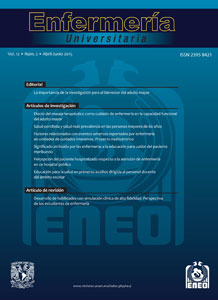Perceived health and real health: prevalence among persons aged 60 and older
Main Article Content
Abstract
Objective: To analyze the health of the population aged 60 and older, and the relationship between their perception of their health and their real condition. The relationship with social- demographic issues such as gender was also assessed.
Method: Descriptive, transversal and prevalence study of 15 Day and 10 Residential Centers in the province of Almería (Spain), with 1,220 persons aged 60 and older (M = 70.9, SD = 7.9), 48.3% male and 51.7% female.
Measurements: Gender, age, civil status, and the presence of pathologies and health problems, as well as the perceived health level were all assessed.
Results: Health problems related to bones and articulations were the most reported. There are significant differences (P=0.000) in the perception of health between both genders; males have a better perception of their health. There is a negative and significant relation ( P < .001) between age and the perception of health. The number of illnesses (r2 = 0.251), age (r2 = 0.010), and gender (r2 = 0.002) are all part of the explicative model of the perception of health.
Conclusions: The number of illnesses, age, and gender are variables which explain a quarter of the subjective perception of health variable, and thus, they indicate a possible use in the planning of health policies.
Publication Facts
Reviewer profiles N/A
Author statements
- Academic society
- N/A
- Publisher
- Universidad Nacional Autónoma de México
Article Details
Dimensions citation
MÉTRICAS
Enfermería Universitaria by Universidad Nacional Autónoma de México it is distributed under the License Creative Commons Attribution - NonCommercial - NoDerivatives 4.0 International
Accepted and published articles become open-access under the terms of the Creative Commons CC BY-NC-ND 4.0 license, which authorizes the reproduction and sharing without commercial purposes, provided the corresponding acknowledgments to their authors. Authors are allowed to manage a self-archive copy of the article’s published version so that they can open-access it in their personal or institutional web pages, and/or any other broad-diffusion space.



